
The Oakland Raiders are a professional American Football team based in Oakland, California. They were founded in 1960. For the first ten seasons of their existence, the Raiders belonged to the American Football League; they have been members of the National Football League since the 1970 AFL–NFL merger. As of 2012, the Raiders belong to the Western Division of the American Football Conference. Over fifty-two seasons of football, the Raiders have experienced a considerable amount of success. Entering the 2012 season the Raiders sported a lifetime record of 426-351-11 (winning 54% of games played), with a playoff record of 25-18.
In the club's first three seasons (1960-1962), the team struggled both on and off the field. In 1963, the Raiders appointed eventual owner/general manager Al Davis to the position of head coach. Under Davis' guidance, the team's fortunes improved dramatically. In 1967, the Raiders reached the postseason for the first time; they went on to win their first, and only, AFL title that year by beating the Houston Oilers in the Championship Game, but they were defeated by theGreen Bay Packers in Super Bowl II.
The Raiders' run of success intensified in the 1970s; during this time, they won six division titles and played in six AFC championship games. In 1976, the team captured its first championship by defeating the Minnesota Vikings in Super Bowl XI. In 1980, the Raiders unexpectedly won a second championship by defeating the Philadelphia Eagles in Super Bowl XV. Two years later, the franchise relocated to Los Angeles. In 1983 (their second season since the move), they defeated the Washington Redskins in Super Bowl XVIII to capture a third championship. The Raiders' fortunes declined considerably following the 1985 season; they would win just one division title (1990) and two playoff games over their final nine seasons in Los Angeles. In 1995, the team returned to Oakland.
In the early 2000s, the Raiders experienced a massive (albeit brief) resurgence; their renaissance culminated in a 2002 loss to the Tampa Bay Buccaneers in Super Bowl XXXVII. The team struggled significantly in the years following the Super Bowl loss. While the Raiders' fortunes somewhat improved in 2010 and 2011, they have not reached the playoffs (or attained a winning record) in 10 seasons. They most recently finished 4-12 in 2012.
Today, the Raiders are known for their extensive fan base and distinctive team culture. Since 1960, the team has won fifteen division titles (three AFL and twelve NFL), three Super Bowls, four AFC titles (1976, 1980, 1983, and 2002) and anAFL Championship. Thirteen former members of the team have been enshrined in the Pro Football Hall of Fame.
History
Main article: History of the Oakland Raiders
The Beginning 1959 &The Early Years (1960-62)
Having enjoyed a successful collegiate coaching career at Navy during the 1950s, San Francisco native Eddie Erdelatz was hired as the Raiders first head coach. On February 9, 1960, after previously rejecting offers from the NFL'sWashington Redskins and the AFL's Los Angeles Chargers, Erdelatz accepted the Oakland Raiders head coaching position. In January 1960, the Raiders, originally scheduled to play in Minnesota, was the last team of eight in the new American Football League to select players, thus relegated to the remaining talent available. The 1960 Raiders 42-man roster included 28 rookies and only 14 veterans. Among the Raiders rookies were future Pro Football Hall of Fame inductee centerJim Otto, and a future Raiders head coach, quarterback Tom Flores. In their 1960 debut year under Erdelatz the Raiders finished their first campaign with a 6–8 record. While off the field, Erdelatz battled an ulcer caused by numerous conflicts with the team's front office. Ownership conflicts prevented the team from signing any top draft picks the next season. On September 18, 1961 Erdelatz was dismissed after being outscored 99-0 in the first two games of the Raiders 1961 season.
On September 24, 1961, after the dismissal of Eddie Erdelatz, management appointed Los Angeles native and offensive line coach Marty Feldman to the Raiders head coaching job. Under Feldman, the team finished the 1961 season with a 2–12 record. Feldman began the 1962 season as Raiders head coach but was fired on October 16, 1962 after a dismal 0–5 start. From October 16, 1962–December 16, 1962, the Raiders then appointed Oklahoma native and assistant coach Red Conkrightas head coach. Under Conkright, the Raiders' only victory was its final game of the season, finishing with a 1–13 record. Following the 1962 season the Raiders appointed Conkright to an interim mentor position. Under the Raiders first three head coaches since entering the AFL, the team's combined three-year performance was a disappointing 9–33 record.
Oakland, The AFL and Al Davis (1963–69)
(1963–66) Davis Became Head Coach/General Manager, Then AFL Commissioner (1966)
After the 1962 season, Raiders managing general partner F. Wayne Valley hired Al Davis as Raiders head coach and general manager. At 33, he was the youngest person in professional football history to hold the positions.[3] Davis immediately began to implement what he termed the "vertical game," an aggressive offensive strategy inspired by the offense developed by Chargers head coach Sid Gillman.[4] Under Davis the Raiders improved to 10–4, and he was named the AFL's Coach of the Year in 1963. Though the team slipped to 5–7–2 in 1964, it rebounded to an 8–5–1 record in 1965.
In April 1966, Davis left the Raiders after being named AFL Commissioner, promoting assistant coach John Rauch to head coach. Two months later, the league announced its merger with the NFL. With the merger, the position of commissioner was no longer needed, and Davis entered into discussions with Valley about returning to the Raiders. On July 25, 1966, Davis returned as part-owner of the team. He purchased a 10% interest in the team for $18,000, and became the team's third general partner — the partner in charge of football operations.,[5][6]
Under Rauch, the Raiders matched their 1965 season's 8–5–1 record in 1966 but missed the playoffs, finishing second in the AFL West Division.
1967–69 Oakland Wins AFL Championship & NFL vs. AFL World Championship
On the field, the team Davis had assembled and coached steadily improved. With John Rauch (Davis's hand-picked successor) as head coach, and led by quarterback Daryle Lamonica, acquired in a trade with Buffalo, the Raiders finished the 1967 season with a 13–1–0 record and won the 1967 AFL Championship, defeating the Oilers 40-7. The win earned the team a trip to the Orange Bowl in Miami, Florida in Super Bowl II, January 14, 1968, where they were defeated 33-14 by Vince Lombardi's Packers. The following year, the Raiders ended the 1968 season with a 12–2–0 record winning the AFL West Division title but were defeated 27-23 by the New York Jets in the AFL Championship Game. Citing management conflicts with day-to-day coaching decisions, Rauch resigned as Raiders head coach on January 16, 1969, accepting the head coaching job of the Buffalo Bills.
(1969-78) The John Madden Era and Raiders First World Championship (1976 XI)
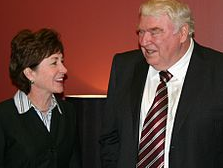
John Madden (right) was head coach of the Raiders for 10 seasons. Madden's overall winning percentage including playoff games ranks second in league history. He won a Super Bowl and never had a losing season as a head coach.
During the early 1960s, John Madden was a defensive assistant coach at San Diego State University under SDSU head coach Don Coryell. Madden credits Coryell as being an influence on his coaching. In 1967, Madden was hired by Al Davis as the Raiders linebacker coach. On February 4, 1969, after the departure of John Rauch, Raiders assistant coach John Madden was named the Raiders sixth head coach. Under Madden, the 1969 Raiders won the AFL West Division title with a 12–1–1 record. On December 20, 1969, the Raiders defeated the Oilers 56-7 in the AFL Division playoff game. In the AFL Conference Championship game on January 4, 1970, the Raiders were defeated by Hank Stram's Chiefs 17-7. The Raiders became one of the most successful franchises in the NFL, winning six division titles along with their first Super Bowl in the 1970s under Madden. Also during Madden's tenure (1969 - 1978) the Raiders never suffered a losing season.
AFL-NFL Merger (1970–81)
1970–71
In 1970, the AFL-NFL merger took place and the Raiders joined the Western Division of the American Football Conference (actually the AFL West with the same teams as in 1969, except for the Cincinnati Bengals) in the newly merged NFL. The first post-merger season saw the Raiders win the AFC West with an 8-4-2 record and go all the way to the conference championship, where they lost to the Colts. Despite another 8-4-2 season in 1971, the Raiders failed to win the division or achieve a playoff berth.
1972–78
The teams of the 1970s were thoroughly dominant teams, with 8 Hall of Fame inductees on the roster and a Hall of Fame coach in John Madden. The 1970s Raiders created the team's identity and persona as a team that was hard-hitting. Dominant on defense, with the crushing hits of safeties Jack Tatum and George Atkinson, the Raiders regularly held first place in the AFC West, entering the playoffs nearly every season. In 1973–77, the Raiders reached the conference championship every year.
This was the era of the bitter rivalry between the Pittsburgh Steelers and Raiders. In the 1970s, the Steelers and Raiders during many of those seasons were the two best teams in the AFC and, arguably, the NFL. The Raiders regularly met the Steelers in the playoffs, and the winner of the Steelers-Raiders game went on to win the Super Bowl in 3 of those instances, from 1974-76. The rivalry garnered attention in the sports media, with controversial plays, late hits, accusations and public statements.
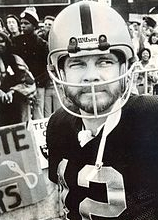
Former Raiders quarterback Ken Stabler. He won the 1974 MVP and led the Raiders to the title in Super Bowl XI.
The rivalry began with and was fueled by a controversial last-second play in their first playoff game in 1972. That season the Raiders achieved a 10-3-1 record and an AFC West title. In the divisional round, they were beaten by the Steelers 13-7 on a play that become known as the Immaculate Reception. The Raiders won the AFC West again in 1973 with a 9-4-1 record. Lamonica was replaced as starting quarterback early in the season by Ken Stabler, who remained the starting quarterback throughout the team's dominant seasons of the 1970s. The Raiders defeated Pittsburgh 33-14 in the divisional round of the playoffs to reach the AFC Championship, but lost 27-10 to the Dolphins.
In 1974, Oakland had a 12-2 regular season, which included a 9-game winning streak. They beat the Dolphins 28-26 in the divisional round of the playoffs in a see-saw battle remembered as the "Sea of Hands" game.[7] They then lost the AFC Championship to the Steelers, who went on to win the Super Bowl. The Raiders were held to only 29 yards rushing by the Pittsburgh defense, and late mistakes turned a 10-3 lead at the start of the fourth quarter into a disappointing 24-13 loss.
In the 1975 season opener, the Raiders beat Miami and ended their 31-game home winning streak. With an 11-3 record, they defeated Cincinnati 31-28 in the divisional playoff round. Again, the Raiders faced theSteelers in the conference championship, eager for revenge; again, the Raiders came up short, as the Steelers won the AFC Championship and then went on to another Super Bowl title. According to John Madden and Al Davis, the Raiders relied on quick movement by their wide receivers on the outside sidelines - the deep threat, or 'long ball' - more so than the Steelers of that year, whose offense was far more run-oriented than it would become later in the 1970s. Forced to adapt to the frozen field of Three Rivers Stadium, with receivers slipping and unable to make quick moves to beat coverage, the Raiders lost, 16-10. The rivalry had now grown to hatred, and became the stereotype of the 'grudge match.'
In 1976, the Raiders came from behind dramatically to beat Pittsburgh 31-28 in a revenge match in the season opener, and continued to cement its reputation for dirty play by knocking WR Lynn Swann out for two weeks with a clothesline to the helmet. Al Davis later tried to sue Steelers coach Chuck Noll for libel after the latter called safety George Atkinson a criminal for the hit. The Raiders won 13 regular season games and a close 24-21 victory over New England in the playoffs. They then knocked out the Steelers in the AFC Championship to go to Super Bowl XI. Oakland's opponent was the Vikings, a team that had lost three previous Super Bowls. The Raiders led 16-0 at halftime, having forced Minnesota into multiple turnovers. By the end, they won 32-14 for their first post-merger championship.
The following season saw the Raiders finish 11-3, but they lost the division title to Denver. They settled for a wild card, beating the Colts in the second-longest overtime game in NFL history, but then fell to the Broncos in the AFC Championship. During a 1978 preseason game, Patriots WR Darryl Stingley was injured by a hit from Raiders FS Jack Tatum and paralyzed for life. Although the 1978 Raiders achieved a winning record at 9-7, they missed the playoffs for the first time since 1971, losing critical games to Seattle, Denver and Miami towards the end of the season.
1979–81 The Tom Flores Era Begins (1979-1987) and Second World Championship (1980 XV)
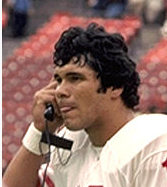
Jim Plunkett led the Raiders to two Super Bowl victories (XV and XVIII). He is the only eligible quarterback to start (and win) two Super Bowls without being inducted into the Pro Football Hall of Fame.
After ten consecutive winning seasons and one Super Bowl championship, John Madden left the Raiders (and coaching) in 1979 to pursue a career as a television football commentator. His replacement was former Raiders quarterback Tom Flores, the first Hispanic head coach in NFL history.[8] Flores led the Raiders to another 9-7 season, but not the playoffs. In the 1980 off-season, quarterback Stabler was traded to the Houston Oilers for Dan Pastorini. In the fifth week of the 1980 season, Pastorini broke his leg and was replaced by former number-one draft pick Jim Plunkett. Plunkett led Oakland to an 11-5 record and a wild card berth. After playoff victories against the Houston Oilers, Cleveland Browns, and San Diego Chargers, the Raiders went to Super Bowl XV, facing the heavily favored Philadelphia Eagles. The Raiders clinched their second NFL championship in five years with a 27–10 win over the Philadelphia Eagles in Super Bowl XV. With the victory, the Raiders became the first ever wild-card team to win a Super Bowl."[9] Two Super Bowl records of note occurred in this game: 1) Kenny King's 80-yard, first-quarter, catch-and-run reception from Jim Plunkett remained the longest touchdown Super Bowl pass play for the next 23 years; and 2) Rod Martin's three interceptions of Eagles' quarterback Ron Jaworski still stands today as a Super Bowl record.[10] Reflecting on the last ten years during the post-game awards ceremony, Al Davis stated "...this was our finest hour, this was the finest hour in the history of the Oakland Raiders. To Tom Flores, the coaches, and the athletes: you were magnificent out there, you really were." [11] The team would not see a repeat performance in 1981, falling to 7-9 and a losing record for the first time since 1963.
The Los Angeles Era (1982-94) and Third World Championship (1983 XVIII)
Prior to the 1980 season, Al Davis attempted unsuccessfully to have improvements made to the Oakland Coliseum, specifically the addition of luxury boxes. That year, he signed a Memorandum of Agreement to move the Raiders from Oakland to Los Angeles. The move, which required three-fourths approval by league owners, was defeated 22–0 (with five owners abstaining). When Davis tried to move the team anyway, he was blocked by an injunction. In response, the Raiders not only became an active partner in an antitrust lawsuit filed by the Los Angeles Memorial Coliseum (who had recently lost the Los Angeles Rams), but filed an antitrust lawsuit of their own.[12] After the first case was declared a mistrial, in May 1982 a second jury found in favor of Davis and the Los Angeles Coliseum, clearing the way for the move.[13][14][15] With the ruling, the Raiders finally relocated to Los Angeles for the 1982 season to play their home games at the Los Angeles Coliseum.
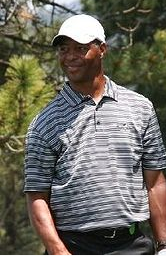
Raider's Hall of FamerMarcus Allen is considered as one of the greatest goal line and short-yard runners in National Football League history.
The team finished 8–1 in the strike-shortened 1982 season, first in the AFC, but lost in the second round of the playoffs to the Jets. The following season, the team finished 12–4 and won convincingly against the Steelers and Seattle Seahawks in the AFC playoffs. Against the Washington Redskins in Super Bowl XVIII, the Raiders built a 21–3 halftime lead en route to a 38–9 victory and their third NFL championship.
The team had another successful regular season in 1984, finishing 11-5, but a three-game losing streak forced them to enter the playoffs as a wild-card, where they fell to the Seahawks.
The 1985 campaign saw 12 wins and a division title, but that was followed by an embarrassing home playoff loss to the Patriots.
The Raiders' fortunes declined after that, and from 1986–89, Los Angeles finished no better than 8–8 and posted consecutive losing seasons for the first time since 1961–62. Also 1986 saw Al Davis get into a widely publicized argument with RB Marcus Allen, whom he accused of faking injuries. The feud continued into 1987, and Davis retaliated by signing Bo Jackson in Allen's place. However, Jackson was also a left fielder for Major League Baseball's Kansas City Royals, and could not play full-time until baseball season ended in October. Even worse, another strike cost the NFL one game and prompted them to use substitute players. The Raiders fill-ins achieved a 1-2 record before the regular team returned. After a weak 5-10 finish, Tom Flores moved to the front office and was replaced by Denver Broncos offensive assistant coachMike Shanahan. Shanahan led the team to a 7-9 season in 1988, and Allen and Jackson continued to trade places as the starting RB. Low game attendance and fan apathy were evident by this point, and in the summer of 1988, rumors of a Raiders return to Oakland intensified when a preseason game against the Houston Oilers was scheduled at Oakland Coliseum.[16]
As early as 1986, Davis sought to abandon the Coliseum in favor of a more modern stadium. The neighborhood around Exposition Park was considered dangerous at the time (which caused the NFL to schedule the Raiders' Monday Night Football appearances as away games - the NFL would not even consider allowing the Raiders to use Anaheim Stadium for Monday night games). In addition to sharing the venue with the USC Trojans, the Coliseum was aging and still lacked the luxury suites and other amenities that Davis was promised when he moved the Raiders to Los Angeles.[17] Finally, the Coliseum had 95,000 seats and the Raiders were rarely able to fill all of them even in their best years, and so most Raiders home games were blacked out in Southern California. Numerous venues in California were considered, including one near Hollywood Park in Inglewood and another in Carson. In August 1987, it was announced that the city of Irwindale paid Davis USD $10 million as a good-faith deposit for a prospective stadium site.[18] When the bid failed, Davis kept the non-refundable deposit.[19][20]
1989–94 The Art Shell and Bo Jackson Era
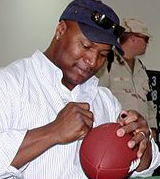
Bo Jackson was the first athlete to be named an All-Star in two major American sports. He also won theHeisman Trophy in 1985.
Negotiations between Davis and Oakland commenced in January 1989, and on March 11, 1991, Davis announced his intention to bring the Raiders back to Oakland.[21] By September 1991, however, numerous delays had prevented the completion of the deal between Davis and Oakland. On September 11, Davis announced a new deal to stay in Los Angeles, leading many fans in Oakland to burn Raiders paraphernalia in disgust.[22][23]
After starting the 1989 season with a 1–3 record, Shanahan was fired by Davis, which began a long-standing feud between the two.[24][not in citation given] He was replaced by former Raider offensive lineman Art Shell, who had been voted into the Pro Football Hall of Fame earlier in the year. With the hiring, Shell became the first African American head coach in the modern NFL era, but the team still finished a middling 8-8.[25]
In 1990, Shell led Los Angeles to a 12–4 record. They beat the Bengals in the divisional round of the playoffs, but Bo Jackson had his left femur ripped from the socket after a tackle. Without him, the Raiders were crushed in the AFC Championship by the Buffalo Bills. Jackson was forced to quit football as a result, although surgery allowed him to continue playing baseball until he retired in 1994.
The team's status faded after the loss. They made two other playoff appearances during the 1990s, and finished higher than third place only three times. In 1991, they got into the postseason as a wild-card after a 9-7 regular season, but fell to Kansas City. 1992 saw them drop to 7-9. This period was marked by the injury of Jackson in 1991, the failure of troubled quarterback Todd Marinovich, the acrimonious departure of Marcus Allen in 1993, and the retirement of Hall of Fame defensive end Howie Long after the 1993 season, when the Raiders went 10-6 and lost to Buffalo in the divisional round of the playoffs. Shell was fired after posting a 9–7 record in the 1994 season.
Back To Oakland (1995–present)
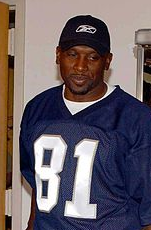
Raiders' wide receiverTim Brown spent 16 years with the Raiders, during which he established himself as one of the NFL's most prolific wide receivers.
On June 23, 1995, Davis signed a letter of intent to move the Raiders back to Oakland. The move was approved by the Alameda County Board of Supervisors the next month,[26] as well as by the NFL. The move was greeted with much fanfare,[27] and under new head coach Mike White the 1995 season started off well for the team. Oakland started 8–2, but injuries to starting quarterback Jeff Hostetlercontributed to a six-game losing streak to end the season, and the Raiders failed to qualify for the playoffs for a second consecutive season.
In order to convince Davis to return, Oakland spent $220 million on stadium renovations. These included a new seating section — commonly known as "Mount Davis" — with 10,000 seats. It also built the team a training facility and paid all its moving costs. The Raiders pay just $525,000 a year in rent — a fraction of what the nearby San Francisco 49ers paid to play at Candlestick Park — and do not pay maintenance or game-day operating costs.
The Jon Gruden Era (1996-2002)
1996-99
After two more unsuccessful seasons (7-9 in 1996 and 4-12 in 1997) under White and his successor, Joe Bugel, Davis selected a new head coach from outside the Raiders organization for only the second time when he hired Philadelphia Eagles offensive coordinator Jon Gruden, who previously worked for the 49ers and Packers under head coach Mike Holmgren. Under Gruden, the Raiders posted consecutive 8-8 seasons in 1998 and1999, and climbed out of last place in the AFC West.
2000
Main article: 2000 Oakland Raiders season
Oakland finished 12-4 in the 2000 season, the team's most successful in a decade. Led by veteran quarterback Rich Gannon(MVP), Oakland won their first division title since 1990, and advanced to the AFC Championship, where they lost 16–3 to the eventual Super Bowl champion Baltimore Ravens.
2001
Main article: 2001 Oakland Raiders season
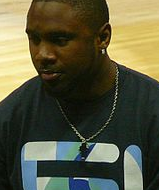
Charles Woodson was the first and is still the only primarily defensive player to win the Heisman Trophy. Woodson was selected by the Oakland Raiders with the fourth pick in the first round of the 1998 NFL Draft.
The Raiders acquired all-time leading receiver Jerry Rice prior to the 2001 season. They had a great start during the mid-season going 10-3 but lost their last 3 games and finished the season with a record of a 10-6 in the wild card spot and won a second straight AFC West title. They defeated the New York Jets 38-24 in the wild card round but lost their divisional-round playoff game to the eventual Super Bowl championNew England Patriots, in a controversial game that became known as the "Tuck Rule Game." The game was played in a heavy snowstorm, and late in the fourth quarter Raiders star cornerback Charles Woodson blitzed Patriots quarterback Tom Brady causing an apparent fumble which was recovered by Raiders linebacker Greg Biekert. The recovery could have potentially led to a Raiders victory; however, the play was reviewed and determined to be an incomplete pass (it was ruled that Brady had pump faked and then "tucked" the ball into his body, which, by rule, cannot result in a fumble—though this explanation was not given on the field, but after the NFL season had ended). The Patriots retained possession and drove for a game-tying field goal. The game went into overtime and the Patriots won 16–13.[28]



















